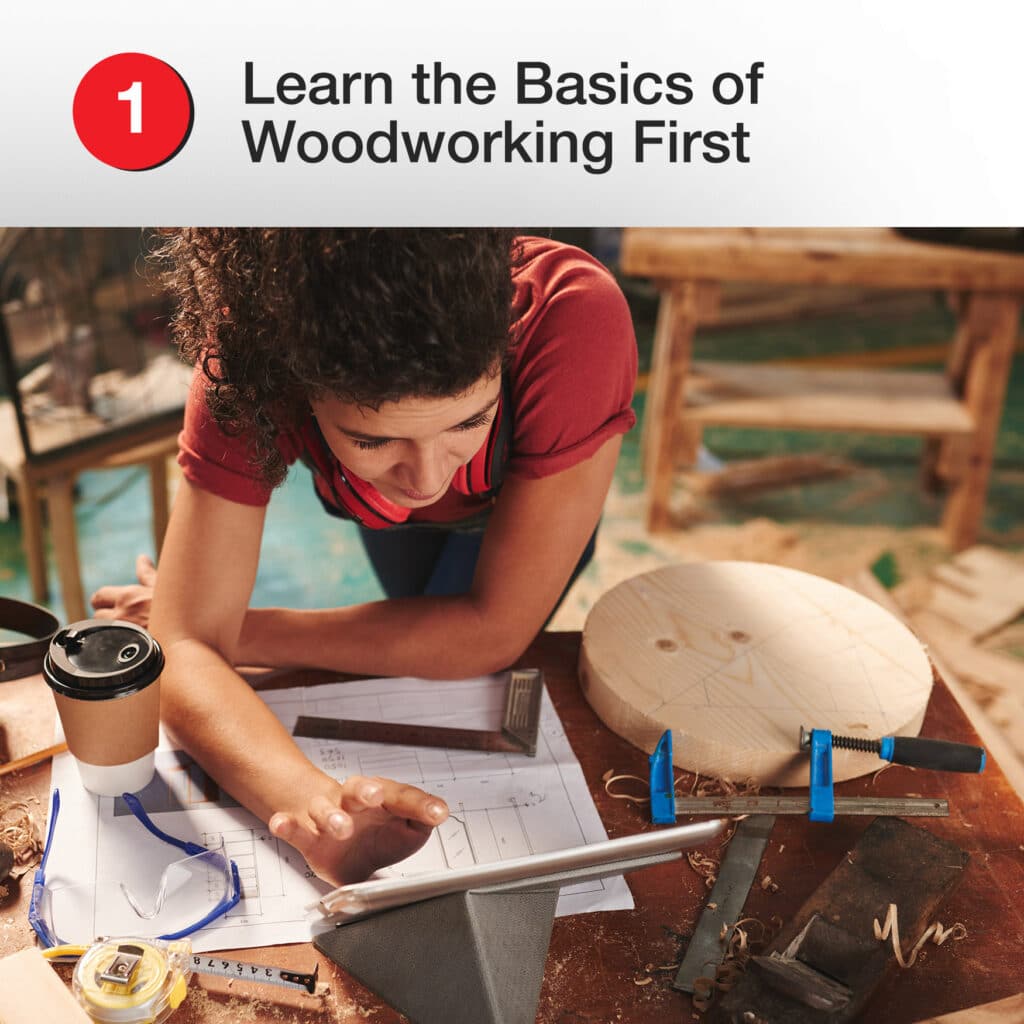Few activities connect us with our ancient ancestors as well as working with wood. The craft of woodworking has been around for thousands of years. And while the tools have gotten a lot more sophisticated, the basic sights, sounds, and smells are the same.
To those in the know, creating objects with wood just feels right. It makes a fascinating hobby or a fulfilling career.
So, whether you’re looking for a way to unwind, trying to finish a DIY project, or searching for a new passion, we put together these seven tips on how to start woodworking.

1. Learn the Basics of Woodworking First
Woodworking might seem simple. Who hasn’t used a saw at some point? The simple essence of this classic craft is part of the appeal. But don’t be fooled. You’ve got plenty to learn, including:
New Lingo
As with any new pursuit, woodworking comes with its own insider terms, including:
- Grain – The pattern of lines in the wood
- Square – A precise right angle or the two-sided device used to measure that precision
- Pilot Hole – A small starter hole for inserting screws or nails or for drilling larger holes
- Crosscut – A cut across the grain
And that’s just the beginning.
New Tools
For many, using new gadgets is the most fun part of any new pursuit. The world of woodworking is full of everything from chisels to sanders to planers, so you’ll want to get to know all the most common tools. Fortunately, we’ve got some details a little farther down.
Woods 101
Think wood is wood? Think again. You’ll need to get to know several fundamental and variable characteristics of wood, including:
- Hardness – Different types of wood have different hardness levels, which can affect how easy or difficult they are to work with.
- Grain – The grain pattern of wood can affect its appearance and how it behaves during the woodworking process.
- Color – Woods offer a huge spectrum of natural hues, from rich, warm cherry and walnut to lighter, more neutral ash and poplar.
- Texture – The texture of wood, whether it’s rough or smooth, can affect how it feels and how it works in a project.
Woodworking Processes
It’s time to familiarize yourself with basic processes such as:
- Cutting – Crosscuts (see above) and rip cuts, angle/miter cuts, curves, etc.
- Turning – Hollowing out a workpiece by turning it in a lathe against a cutting tool (for more on this, check out our list of wood lathe projects)
- Joinery – The many ways you can connect pieces of wood in a project
- Sanding – Techniques for smoothing cut wood pieces
- Finishing – Applying a protective and/or decorative coating
Want some ideas to start practicing these and other techniques? Check out these simple woodworking projects.
For more starter resources, refer to these beginner woodworking tips.

2. Know What Tools You Need and How to Use Them
As you probably can tell, There are a lot of woodworking tools, including hand and power tools, as well as various measuring devices. Start by learning the basics about each, And which ones you should prioritize first.
Hand Tools
With a good set of hand tools and a strong workbench, you can do pretty much anything you’ll need to do in woodworking—shaping, cutting, joining, and more. Some essentials include:
- Handsaw – The quintessential cutting tool
- Chisels – To carve or cut away small pieces
- Plane – For smoothing and shaping the surface
- Screwdrivers – To insert or remove screws or other types of fasteners
- Hammer – For driving nails or removing them, or tapping other tools
- Clamps – Lost of different sizes and types to hold your workpiece in place
- Hand drill – For making small holes
- Hand Planes – For shaping wood
Power Tools
Power tools are awesome, if not always necessary. But they sure can speed up and simplify woodworking. Here are some of the most helpful power tools to have on your workbench:
- Circular saw – For making straight cuts in large sheets of plywood or quick cuts in smaller pieces
- Jigsaw – To make curved or angled cuts
- Router – To shape and cut decorative edges, grooves, slots, and more
- Power drill – Your go-to for making holes or driving screws or other fasteners
- Miter saw – To make precise angled cuts in wood—ideal for molding or framing projects
- Table saw – For making precise straight cuts
- Orbital Sander – For creating a smooth surface using discs made of sandpaper
- Jointer – Used to create a flat surface along a board’s length
- Belt sander – Used for fine shaping of wood using sandpaper
For a deeper dive into tools, check out our top seven woodworking power tools.
One thing about all these power tools is how to accommodate the power part of the equation. You’ll have no problem powering a few of them. But as you expand your shop and increase your workload, you may want more heavy-duty equipment that takes 3-phase electricity.
But most people only have single-phase electricity at home.
What do you do then? Consider getting a three-phase converter. This technology can turn your single-phase into reliable, efficient 3 phase. Plus, you can run other tools off the converter at the same time.
For example, USA-made American Rotary phase converters deliver balanced 3-phase to keep your whole woodshop running. Check out American Rotary phase converters for woodworking.
Measuring Tools
“Measure twice, cut once,” so the saying goes. Here are some of the measuring tools you’ll use:
- Tape measure – For length and width
- Combination square – To check your right angles and as well as measure angles or mark parallel lines
- Calipers – To measure thickness or diameter
- Level – For making sure your projects are straight and even
- Bevel gauge – To measure angles for joinery or decorative elements
Safety Equipment
You’ll be working with sharp cutting tools, powerful equipment, and the potential for flying debris. Proper safety gear (as well as safe techniques) is paramount. Don’t forget:
- Eye protection – Shatter and scratch-resistant safety glasses are crucial.
- Ear protection – Wear ear plugs or headphones to filter loud machinery noise.
- Dust mask – Airborne sawdust can irritate the lungs.
- Dust collection and hazard control – Keep your workspace clean to prevent slips and other accidents!
- Fire Extinguisher – Sawdust can be extremely flammable, so it’s important to have a way to put out a fire in case of an accident.
Seems like a lot of stuff, right?
Don’t worry. You don’t need all these tools at once. And some are more important to get early than others. Start out by filling your toolbox with the basics—here’s a good list of woodworking tools for beginners—and build out from there.
You don’t have to pay top dollar, either. Consider a low-price tool retailer such as Harbor Freight. Or you can find quality used tools in all sorts of places, including yard sales, thrift stores, clearance racks at hardware stores, and pawn shops.

3. Learn How to Pick Good Boards
When you go to a lumber yard, knowing how to select workable workpieces is key to the quality and outcome of any project. Some features to consider:
- Straightness – Look for boards that are straight, with no warping or twisting.
- Knots – Avoid boards with large knots or knots near the edge, which can weaken the wood and make it harder to work with.
- Grain – Look for boards with a consistent grain pattern—no sudden changes in direction or irregularities.
- Color – Look for boards with a uniform color, which suggests consistent density.
- Moisture content – Use a moisture meter. Wood that’s too dry or too wet may crack or warp.

4. Take Local Classes or Try an Apprenticeship
Since woodworking is one of the most popular hobbies in the country, it’s usually pretty easy to find woodworking classes specifically for beginners nearby. Check your local community college or technical college.
Or, for an accelerated career track, look into an apprenticeship or a course through an organization such as Construction Ready or the National Center for Construction Education & Research.

5. Embrace the Community
So many woodworkers out there are eager to share their love for the craft and help you along. Here are just a few of the many ways to connect with this enthusiastic community:
- Publications – Fine Woodworking, Popular Woodworking, Woodsmith, and more
- Local woodworking clubs – Here’s a state-by-state directory
- Shows – Big events such as the AWFS Fair or regional conferences, including The Woodworking Shows

6. Learn from YouTube
If you’re interested in carpentry, you’ve probably already checked out some videos. And now your feed is suggesting more woodworker videos to you left and right.
There are a ton of experienced woodworkers making tutorials on YouTube (TikTok, too, if that’s your thing). It’s a great place for beginners to learn about techniques, project ideas, or new products. Or check out more skill-training-focused resources such as Udemy.

7. Don’t Rush Into It
We don’t want anyone to get overwhelmed or discouraged. We want you to learn, grow, and enjoy the journey of woodworking!
Wait a bit to try to build that birdhouse. To begin with, go with something easy like the ones you can find in this list of simple DIY woodworking projects. You might be surprised at all the cool stuff you can do with beginner skills.
Then level up from there. Be patient with yourself as you improve. Bit by bit, cut by cut, you’ll rise to take on more complex tasks.
Now Go Make Something Awesome
Don’t rush, but do get started! Carpentry is a fun, wholesome, and wholly satisfying craft.
But it’s not the easiest pastime. Start with these 7 tips to get into woodworking.
Take your time, and don’t give up. Before you know it, you’ll be creating all kinds of beautiful, practical wood fixtures, furniture, tools, decorations, and more!



